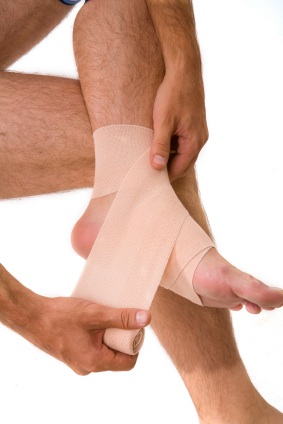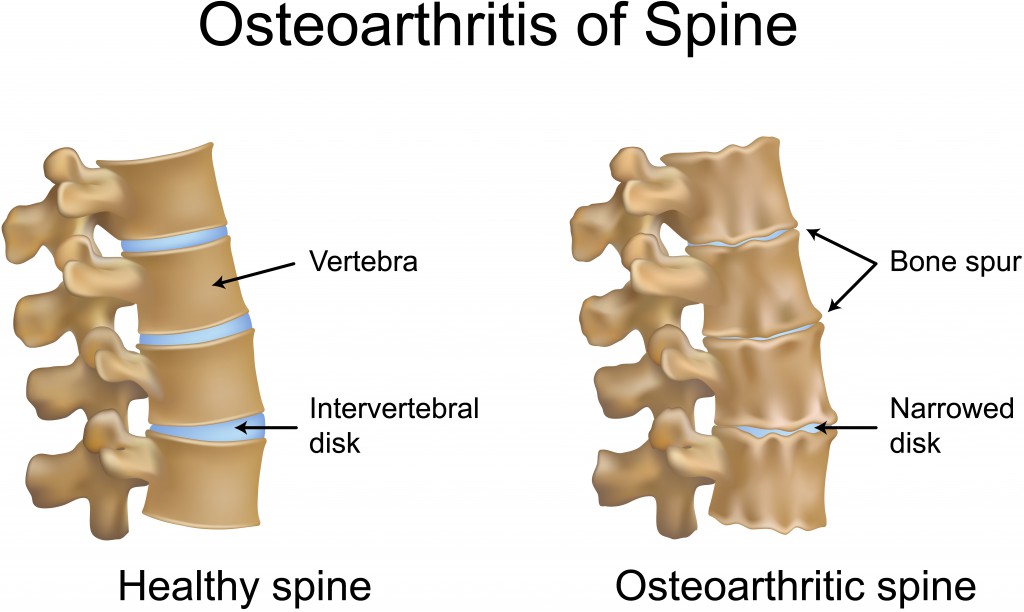Bone spurs are ossified or calcified growths that develop over normal bone. Despite their name, they are not jagged or sharp; they mostly resemble tiny bits of gravel attached to the bone most often at the site of an articulating joint. Often they are asymptomatic and go undetected for years, only turning up as an oddity on an x-ray. But when soft tissues like ligaments, tendons or nerves rub across bone spurs, the results can be quite painful, and when bone spurs develop on the interior surface of a joint, they can compromise range of motion. Bone spurs develop most commonly along the bones of the spine, shoulders, hands, hips, knees, and feet.
Bone spurs can occur as a normal part of the aging process or in association with other disease processes such as spinal stenosis or plantar fasciitis. Sometimes spurs will break off from the underlying bone and become suspended inside the synovial fluid inside a joint, causing a “locking” sensation and preventing range of motion.
Unless they are causing pain or damaging, bone spurs do not require intervention. When intervention is indicated, treatment will address either the underlying cause of bone spur formation, symptoms or surgical removal of the bone spur itself. Diagnosis will be based on the patient history your physician takes from you, a physical exam and imaging tests that may include X-rays, computerized tomography (CT) scans or magnetic resonance imaging (MRI) scans.
Alternative Names
The formal name for bone spurs is osteophytes – from the Latin and the Greek: “osteo” (bone) and “phyte” (plant.) They are sometimes also called osteophymas.
Bone Spurs? Get Remedies Fast!
Bone spurs are sometimes named for the part of the body on which they occur. For example, when an inflammation of the Achilles tendon leads to a growth on the calcaneus, that growth may be called a heel spur.
Bone spurs that affect the metatarsophalangeal, or MTP joint – the joint at the base of the big toe – are called hallux rigidus.
Symptoms of Bone Spurs
Frequently bone spurs cause no symptoms at all. When they are symptomatic, the symptoms are generally associated with their anatomical location.
- Heel spurs may cause tenderness, foot pain and occasionally swelling which may compromise walking and other weight-bearing activities. When the spur occurs on the calcaneus (heel bone,) the entire bottom of the foot may become inflamed. This inflammation is called plantar fasciitis.
- When bone spurs develop in the vertebrae foramen – openings through which nerves travel – they occlude the opening and press on the nerve. Pinched nerves lead to numbness, tingling, pain and weakness in the area of the body associated with that nerve. Back pain, neck pain and radiating pain affecting the arms and legs are also very common. In severe cases, bladder and bowel dysfunction may occur.
- Bone spurs that develop in the area around knee joints make it painful to bend or extend your leg.
- When a bone spur develops in the cervical spine (neck) area, it causes stiffness and pain in the neck that may radiate into your back. Bone spurs in this area may be dangerous: when they protrude inward, they can make it difficult or even painful to swallow or breath, and they can push against veins restricting the blood flow to your brain.
- When a bone spur develops in the shoulder area, it can impinge on rotator cuff tendons, causing swelling, tendonitis and reduced range of motion in the accompanying arm.
- Bone spurs sometimes develop on the bones of your fingers. You can see them as tiny knobs and protuberances.
- Hallux rigidus may cause stiffness and an inability to bend your toe. Additionally you may experience swelling as well as pain especially when you use your toes to “push off” as you walk.
Causes of Bone Spurs
Bone spurs commonly develop through one of three processes:
Degenerative Joint Disease
As our bodies age, the cartilage cushioning our joints begins to break down, eventually degenerating altogether as part of a disease process called osteoarthritis. (Cartilage contains no blood vessels, and the body regenerates it very slowly if at all.) The body may attempt to repair this damage by spurring the growth of new bone at the joint site. This occurs most often in the shoulder, elbow, hip, knee and ankle
Calcium Deposits
Sometimes the areas where ligaments or tendons attach to the bone become calcified – i.e. calcium salts build up in the soft tissues, causing them to harden.
Your body uses calcium in many ways. The mineral is a structural component of bones and teeth, accounting for one to two percent of adult body weight; and on a cellular level, it regulate the permeability of biological membranes which control muscle and nerve functions.
When calcium absorption is impaired and too much calcium is circulating in the blood stream, the result can be abnormal deposition of calcium in tissues. Calcium deposits are most common in women between the ages of 35 and 65 – the same group that’s most prone to developing osteoporosis.
Bone spurs that develop secondary to calcium deposits can occur around the Achilles tendon, the bottom of the foot and in the coroacoacromial ligament of the shoulder.
Trauma
When trauma occurs to a bone or a joint, damaging the underlying bone, the body may try to heal the damage by stimulating new bone growth. That new bone growth can sometimes result in the formation of bone spurs.
Risk Factors for Bone Spurs
A number of different factors contribute to the likelihood of developing bone spurs. Among them are:
- Aging. Many medical experts think the development of bone spurs is a normal consequence of aging, that it is the body’s way of thickening and stabilizing ligaments that have loosened over time through wear and tear on the body.
- Heredity. In particular, heredity may influence the body’s calcium absorption mechanisms.
- Injuries. Bone spurs are a common aftermath of sports related and other traumatic injuries (including motor vehicle accidents.) Bone spurs grow to protect the injured area from further injury.
- Nutrition. Nutrition plays an important role in calcium absorption.
- Lifestyle choices. Certain lifestyle choices – for example, smoking – interfere with calcium metabolism within the body which in turn may lead to the formation of bone spurs.
- Poor posture. When poor posture goes uncorrected, the spine loses support. The body may try to compensate by growing extra bone.
- Disease processes. A number of disease processes are associated with the development of bone spurs. Among them are:
- Osteoporosis. Osteoporosis may lead to the degeneration of the cervical vertebrae, thereby prompting the body to compensate for bone loss by growing bone spurs in an effort to stabilize the spinal column.
- Osteoarthritis. Osteoarthritis breaks down cartilage within the joints; bone spurs grow in these damaged areas.
- Spondylosis (spinal osteoarthritis.) Spondylosis is a degenerative affecting the spinal column. It can manifest in the cervical, thoracic or lumbar areas.
- Spinal stenosis. Spinal stenosis is a narrowing of the spinal cord in the cervical, thoracic or lumbar regions which causes pressure on the spinal cord or spinal nerves associated with that region. It is often caused by bone spurs.
Bone Spur Prevention Tips
There is really no way to prevent bone spurs since many medical experts consider them either a part of normal aging or associated with degenerative processes such as arthritis. Staying physically active and fit will reduce many of the symptoms associated with bone spurs however.
Home Therapies for Bone Spurs
There is much you can do at home to manage the symptoms of bone spurs.
Your first goal is to reduce the associated inflammation. Apply a cold pack to the affected area. Heat packs raise temperature and increase blood circulation, so they are counter-indicated in situations where inflammation exists. Cold therapy with ice, on the other hand, reduces swelling and pain by constricting blood vessels which helps relieve the inflammation.
Anti-Inflammatory Medication
Non-steroidal, anti-inflammatory medications such as ibuprofen (available over the counter as Advil) and naproxen (available over the counter as Aleve) will also help reduce the swelling. Ibuprofen should always be taken with food to minimize the possibility of an upset stomach, and should be avoided if you are taking diuretics or blood pressure medication because it can reduce their potency.

Ibuprofen is commonly available over the counter; its recommended dosage is 400 mg every eight hours. Naproxen works by targeting specific body proteins that are responsible for inflammation and pain. Naproxen should be avoided by people who are taking anti-coagulants (blood thinners) because it too thins the blood and may cause bleeding. The usual dose is 250 to 500 mg of the drug twice each day.
Herbal Remedies
Two popular herbal remedies for the alleviation of symptoms associated with bone spurs are turmeric and flaxseed. Curcumin, the yellow pigment found in turmeric, has scientifically proven anti-inflammatory and anti-oxidant properties and has been used in traditional Asian medicine for centuries to treat arthritis pain; 500 – 1,000 mg taken three to four over a six week course is said to alleviate bone spurs.
Warm compresses made from linseed oil, applied to the affected area, have proven to be an effective treatment for pain. Another herbal remedy found to be effective for acute symptoms of bone spur is dimethyl sulfoxide (DMSO,) a colorless and slightly oily liquid derived from lignin, the substance that bonds the cells of trees together.
When To Visit Your Physician
If your symptoms are so severe they don’t respond to home remedies, a visit to your physician’s office may be in order. Before you go, write down a list of the symptoms you’ve experienced to refer to while speaking with your physician. Be sure to include information about any injuries you have suffered that may have damaged the affected joint.
Once your at your physician’s office, she will ask you for information about the nature of your symptoms, the duration of your symptoms, the severity of your pain, other medical conditions you may have been diagnosed with and what medications you are taking for them. She may also make out a family tree to ascertain whether anyone in your family suffers from bone disorders.
After she finishes your history, your doctor will perform a physical exam to understand the source of your discomfort more thoroughly. She may palpate the area of the joint to see if she can feel the bone spur.
If your physician diagnoses a bone spur, she will order imaging studies to confirm the diagnosis. Most often these will be a simple X-ray, but in cases where the bone spur may be difficult to visualize, she may order a CT or MRI scan.
Medical Treatment of Bone Spurs
Medical treatment approaches depend upon the severity of the underlying symptoms.
For a person suffering from mild bone spur symptoms, treatment with anti-inflammatory drugs and muscle relaxants for approximately four to six weeks has been found to reduce pain, inflammation, and associated fever. In addition to ibuprofen and naproxen – at higher doses than you would take without consulting a doctor – COX-2 inhibitors have been found effective. COX-2 inhibitors work by inhibiting the chemical reactions that cause inflammation within the body. They don’t impair blood clotting or cause gastrointestinal distress. Some studies suggest that they may increase the likelihood of heart attack or stroke so they should be used with caution and never without a physician’s prescription.
Physical Therapy
Physical therapy can also be helpful with impaired range of motion. Exercise programs will generally involve a combination of aerobic conditioning, stretching, and muscle-building exercises to help you strengthen weaknesses and regain lost muscle tone.
In cases where symptoms are more severe but surgery may not be an option, cortisone or epidural steroid injections have proven helpful for back or spinal pain. The procedure can take place in a hospital, clinic, or surgery center. The effects of the procedure are only temporary so you may have to return for a follow-up injection. Physicians will perform the procedure up to three times in a single year.
Surgery
Bone spurs that cause great pain and/or impose severe limitations on your range of motion may require surgery. The specific surgical procedure will depend upon the location of the bone spur. Bone spurs are often removed as part of a more comprehensive surgery: during joint replacement, for example, the surgeon will often remove bone spurs to make sure the joint replacement fits right.
Surgery to remove bone spurs may either be done as a simple open procedure or as part of an arthroscopy using specialized tools that often include a tiny camera that allows the surgeon to see inside your joint.


6 Comments
helloo,
my name is manjulagopal my question is my son is 5 yrs old. there is an extra growth of bone on his left knee. There will be any problem in future please suggest me i very much worried.
My knee cartiledge is damaged.Can it be repaired by medicines?.I have been advised to take Calcium.I understand absorption of cal.through allopathic medicines is very less(hardly 7-8 %).i am told to take herbal calcium through “Bone Active’ for better absorption.Kindly advise correct position.
Hi i have a bone spur in my left nostril. What can i do to remove it or to stop it’s growth without surgery??
thanks
Hello ..
My name s shru..
My sister s suffering frm brain tumber , now she s gud , due to tumer she has got a extra growth of bone on her left hip… is there s any herbal home made to disolve the bone , kindle do help me out …
Hi, I’m developing cyst on my fingers and bone spurs.